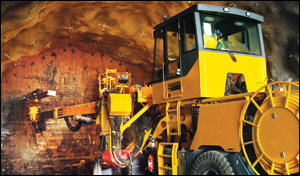- Home
- Real Estate
- Light at the End of the Tunnel

Light at the End of the Tunnel
A variety of tunnelling and trenching equipment is used for underground infrastructure construction and mining operations. While markets for construction equipment used over ground are passing through a rocky road, it's smooth sailing down under.
Bright prospects For his part, Kapil Bhati, Managing Director, Robbins Tunneling & Trenchless Technology (I), expects 20-30 per cent annual growth in the market. 'A lot of hydroelectric power projects are in the process of award and may be finalised in the near future,' he observes. 'Looking at the success of the Delhi Metro, nine new states have proposed metro rails. Road tunnel and micro-tunnelling projects for utilities are also coming up. Such projects are likely to require hard rock, EPB machines and small boring units of different diameters.'
'We foresee a huge potential market for tunnel excavators in India given the number of tunnelling projects coming up,'says Manish Peswani, Head of Sales, Liebherr India.'Afcons, L&T, Navayuga Engineering and HCC are a few early takers for Liebherr's compact tunnel excavator, which is extremely robust and reliable, and boasts working attachments that rotate 2 + 45¦ and can thus facilitate the excavation of the entire tunnel profile in a single operation.'
Anil Sachdev, President- Equipment Division, Salgaocar Engineers, sees ample opportunities for tunnelling equipment in hydroelectric, sewage, irrigation, road and railway projects. 'The most popular Inter Techno Commerce SA models that we market in India are the ITC 120, suitable for working in tunnels with diameter between 3 m and 4.7 m and ITC 312, suitable for tunnels with diameter from 4.5 m to 8 m,ö he shares. And BV Raisinghani, President (Purchase), Jaiprakash Associates, affirms, 'Demand for specialised underground equipment is continuously increasing, mostly for drilling jumbos and mining loaders and trucks.'
Key differentiators
As market competition heats up, service is emerging as a key differentiator between suppliers. Robbins India has started to offer customers value-added services such as expert manpower to run the machines (see case study) and the assured supply of cutters, spares and conveyors to maximise production.
In keeping with growing user cost consciousness, Robbins is entering into machine buyback arrangements with customers. 'Assuring customers of getting back a major chunk of their investment is a great sales driver,' says Bhati. 'Customers want to use advanced technology but many express concern about tying up funds in huge investments in equipment.'
Tailored cuts
Speed is a vital measure of the efficiency of tunnel excavators, which influences the capability of these machines to work economically. ôBut as these machines work in very harsh conditions, which vary from place to place, high hydraulic capacity and operational fittings tailored to the particular application are musts,ö opines Peswani.
Understanding the need to provide customised machines for different underground projects, Robbins has introduced the country to 10-m diameter, double-shield, hard rock tunnel boring machines (TBMs). Two such machines have been deployed for the creation of a 43.5-km water transfer tunnel in Andhra Pradesh, which will be the world's largest tunnel without intermediate access. Robbins has also brought to India a 10-m diameter, single-shield, high-performance hybrid EPB/hard rock TBM for a water tunnel in Madhya Pradesh. Also, Robbins is introducing technologies to enhance the productivity of machines. Sensor technology helps operators to identify the wear of cutters from the control cabin and take timely action to increase the life of cutters and other parts. A foam spray system from the cutter head reduces friction on the cutters, thereby extending the life of installed cutting tools.
In the case of tunnel loading equipment, all ITC models consist of a boom system mounted on a specially designed crawler-mounted excavator with muck conveying system and loading arrangement at the rear side of the machine for directly loading the blasted material onto a dumper or rail car. But users must choose between the standard unit fitted with bucket and the hammer fitted unit and one featuring both tools. According to Sachdev, 'A hammer is recommended where drilling and blasting is not possible and excavation has to be done in poor geological conditions.'
Raisinghani emphasies that accurate purchasing can help drive cost efficiency. 'Manufacturers such as Atlas Copco, Caterpillar and Sandvik offer underground mining trucks and loaders in various sizes and configurations (including ejector body options) to match mineral conditions and production demands,' he says. 'Getting machines to meet your specific need helps maximise productivity and lower the cost per tonne.'
Customisation is the order of the day where shaft jumbos for hydropower projects and coal mining are concerned as well. ,Because of the varied requirements of shaft sinking operations, shaft jumbos are built to customer's specifications, either as slung-to-surface or installed on the galloway,' observes Raisinghani. 'They are offered in a one, two or three-boom configuration with electric or hydraulic and pneumatic versions. The electric power unit offers the advantage of lighter weight while the pneumatic power unit is preferred in situations where mine electricians are hard to come by.'
Productivity gains
Awareness is growing about the productivity gains from using specific equipment for certain jobs. As an example, Sachdev points out that using ITC tunnel loading equipment in conjunction with drilling jumbos can cut loading time by 40 per cent vis-a-vis conventional loading equipment such as load haul dumpers and excavators. Additionally, ITC tunnel loading equipment operates on electric power while working on the face (and on diesel in transport mode), which offers better ventilation and hence working conditions than diesel-operated equipment.
In Norway, Veidekke Entreprenor, a contracting company, set a record of excavating 175.8 m in a week using the ITC 312 with low-profile dump trucks. This was the Kjosnesfjorden Hydro Project, which entailed excavating 21.5 km of tunnel of diameter of 16 sq m by the drill and blast method. The biggest time saver was speedy mucking out cycles. The ITC loader has a capacity of 4-5 cu m per minute for rapid loading of the 10-11 cu m or 20-tonne PAUS trucks. Roughly 120-130 cu m of muck created by each 4.5-m pull/round was mucked out in 60-90 minutes. This Norwegian feat inspired HCC to purchase three ITC 312s for its Dagachu Hydroelectric Project in Bhutan (see case study).
According to Sachdev, ôContractors in India, such as Jaiprakash Industries, HCC, Gammon India, AD Hydro, Coastal, Lanco and NSL Power, are achieving excavation rates of 150-170 m per month with ITC tunnel loading equipment. Higher output and long life help offset the higher landed cost of the equipment, which ranges from Rs 53 million to Rs 73 million including customs duty.' Driven by the right priorities, leading contractors appear poised to set new milestones in tunnel excavation.
Go full throttle:
How to maximise productivity
Clearly, equipment availability is no longer an issue for construction companies. The biggest challenge facing companies today is maximising the output of equipment such as TBMs, boomers and other supporting machines. Pankaj Agarwal, President EPC, GVK, shares a few observations that keep productivity down: 'We lag in fuel supply needed for this major equipment, whether it is power, water or any other fuel. Inputs must be continuously available. Another flaw is failing to organise other activities that are part of the complete operational cycle. Sometimes, we invest in major equipment but fail to achieve the high productivity rates it is capable of because of the poor efficiency of minor equipment.'
To enhance the output of major equipment and get maximum value for capital invested, Agarwal recommends looking at the complete cycle. According to him, these are the key issues to focus on:
- Create an efficient team (including the operator) for all activities.
- Ensure adequate fuel supply for equipment.
- Ensure proper ventilation and a safe working environment for operators and others.
- Ensure adequate supplies of the explosives and tools needed to achieve progress.
- Create a support system or treatment based on the location and rock and soil conditions.
- Ensure that mucking activities create sufficient fronts for subsequent activities.
- Provide adequate manpower for achieving continuous progress over the complete cycle.
- Have on hand a survey and technical team to address the uncertainties faced during execution.
- Create a mechanical team equipped with adequate spares to reduce machinery downtime.
- Closely follow up work to ensure that the estimated complete cycle time is achieved and adequate fronts are created.
Case in point: Vendors on the job
Equipment: Robbins 6.25-m main beam tunnel boring machine
Vendor: Robbins India
Project: Mumbai Water Supply Tunnel, an 8.3-km water transfer project
Operator: Robbins India has provided the manpower crew after selling the machine to the customer.
Client: Unity-IVRCL JV
Start of boring: April 2012
Achievement: It is excavating at a good rate even achieving over 600 m in a few months. As a result, 50 per cent of the tunnel has been completed in one year.
Case in Point: Moving forward at full speed
Equipment: ITC 312 H3 tunnel loading equipment
Vendor: Manufactured by Kaelble GmbH and marketed worldwide by Inter Techno Commerce SA (ITC Schaeff), Switzerland
Project: Dagachu Hydroelectric Project, Bhutan
Operator: HCC
Client: HCC
Start of operations: March 2010
Achievement: HCC achieved a progress of 150-170 m per month, excavating a 5.1-m diameter tunnel. In all, this project entails excavating 7.7 km of tunnel.
Perspective on tunnelling technology: Jackhammers vs Boomers vs TBMs
Tunnelling technology available in India has undergone a sea change from when jack hammers were deployed for drilling and blasting. Today, contractors can additionally choose from Boomers or Tunnel Boring Machines (TBMs). According to Vaibhav Patel, Deputy Director, Patel Engineering, 'Boomers are the perfect machines, especially for projects involving tunnelling in the Himalayan belt from Jammu & Kashmir in the North right up to Mizoram in the Northeast where the geology of the strata keeps changing. In hard strata, boomers give excellent time cycles and pulls whereas in soft strata they are used for umbrella pipe forepoling. In comparison, TBMs haven't been very successful in such conditions. The high investment in TBMs vis-a-vis boomers, minimum six to seven times, makes their usage totally unviable in normal circumstances for contractors. TBMs are used only where they are mandated by the client who could probably gain in terms of revenue owing to extremely early commissioning of the project or where there are limitations as drilling and blasting for tunnelling under cities and urban areas can be risky. We have used TBMs for our Mumbai Water Supply Project for precisely this reason. Jack hammers aren't efficient in terms of timelines, and hence used only for small tunnels or limited areas. In contrast, boomers have proved to be a boon to contractors economically as well in terms of time efficiency. Their life expectancy is beyond 10 years and they can be used for multiple projects. Additionally, hydraulic booms have replaced manpower, thus tremendously increasing operational safety as well as productivity.'
Case in Point: Major technology gains
Equipment: L2D boomers (with two booms and forepoling attachment)
Vendor: Atlas Copco India
Project: Northeast Frontier Railway, Manipur
Operator: Patel Engineering, Mumbai
Client: Patel Engineering, Mumbai
Start of boring: 2011
Achievement: Atlas Copco boomers are a leap in technology. Previously, a number of jack hammers used to be deployed depending on the cross-sectional area. Boomers can work faster and achieve greater drilling lengths, thus achieving higher pull. With boomers, the risk factor has reduced tremendously and safety has improved especially in soft strata. Atlas Copco boomers are working in 75 per cent of the 28 tunnels being drilled and blasted for the Northeast Frontier Railway. These boomers are convenient, multipurpose equipment and additionally handy for slope protection anchors, rock bolting, grouting, etc. Grabbing the opportunity, Atlas Copco has stationed service engineers as well as spares stockyard in the northeast region to the advantage of all contractors.
Vendors can see bright opportunities for their array of tunnelling and trenching equipment, discovers CHARU BAHRI. A variety of tunnelling and trenching equipment is used for underground infrastructure construction and mining operations. While markets for construction equipment used over ground are passing through a rocky road, it's smooth sailing down under. Bright prospects For his part, Kapil Bhati, Managing Director, Robbins Tunneling & Trenchless Technology (I), expects 20-30 per cent annual growth in the market. 'A lot of hydroelectric power projects are in the process of award and may be finalised in the near future,' he observes. 'Looking at the success of the Delhi Metro, nine new states have proposed metro rails. Road tunnel and micro-tunnelling projects for utilities are also coming up. Such projects are likely to require hard rock, EPB machines and small boring units of different diameters.' 'We foresee a huge potential market for tunnel excavators in India given the number of tunnelling projects coming up,'says Manish Peswani, Head of Sales, Liebherr India.'Afcons, L&T, Navayuga Engineering and HCC are a few early takers for Liebherr's compact tunnel excavator, which is extremely robust and reliable, and boasts working attachments that rotate 2 + 45¦ and can thus facilitate the excavation of the entire tunnel profile in a single operation.' Anil Sachdev, President- Equipment Division, Salgaocar Engineers, sees ample opportunities for tunnelling equipment in hydroelectric, sewage, irrigation, road and railway projects. 'The most popular Inter Techno Commerce SA models that we market in India are the ITC 120, suitable for working in tunnels with diameter between 3 m and 4.7 m and ITC 312, suitable for tunnels with diameter from 4.5 m to 8 m,ö he shares. And BV Raisinghani, President (Purchase), Jaiprakash Associates, affirms, 'Demand for specialised underground equipment is continuously increasing, mostly for drilling jumbos and mining loaders and trucks.' Key differentiators As market competition heats up, service is emerging as a key differentiator between suppliers. Robbins India has started to offer customers value-added services such as expert manpower to run the machines (see case study) and the assured supply of cutters, spares and conveyors to maximise production. In keeping with growing user cost consciousness, Robbins is entering into machine buyback arrangements with customers. 'Assuring customers of getting back a major chunk of their investment is a great sales driver,' says Bhati. 'Customers want to use advanced technology but many express concern about tying up funds in huge investments in equipment.' Tailored cuts Speed is a vital measure of the efficiency of tunnel excavators, which influences the capability of these machines to work economically. ôBut as these machines work in very harsh conditions, which vary from place to place, high hydraulic capacity and operational fittings tailored to the particular application are musts,ö opines Peswani. Understanding the need to provide customised machines for different underground projects, Robbins has introduced the country to 10-m diameter, double-shield, hard rock tunnel boring machines (TBMs). Two such machines have been deployed for the creation of a 43.5-km water transfer tunnel in Andhra Pradesh, which will be the world's largest tunnel without intermediate access. Robbins has also brought to India a 10-m diameter, single-shield, high-performance hybrid EPB/hard rock TBM for a water tunnel in Madhya Pradesh. Also, Robbins is introducing technologies to enhance the productivity of machines. Sensor technology helps operators to identify the wear of cutters from the control cabin and take timely action to increase the life of cutters and other parts. A foam spray system from the cutter head reduces friction on the cutters, thereby extending the life of installed cutting tools. In the case of tunnel loading equipment, all ITC models consist of a boom system mounted on a specially designed crawler-mounted excavator with muck conveying system and loading arrangement at the rear side of the machine for directly loading the blasted material onto a dumper or rail car. But users must choose between the standard unit fitted with bucket and the hammer fitted unit and one featuring both tools. According to Sachdev, 'A hammer is recommended where drilling and blasting is not possible and excavation has to be done in poor geological conditions.' Raisinghani emphasies that accurate purchasing can help drive cost efficiency. 'Manufacturers such as Atlas Copco, Caterpillar and Sandvik offer underground mining trucks and loaders in various sizes and configurations (including ejector body options) to match mineral conditions and production demands,' he says. 'Getting machines to meet your specific need helps maximise productivity and lower the cost per tonne.' Customisation is the order of the day where shaft jumbos for hydropower projects and coal mining are concerned as well. ,Because of the varied requirements of shaft sinking operations, shaft jumbos are built to customer's specifications, either as slung-to-surface or installed on the galloway,' observes Raisinghani. 'They are offered in a one, two or three-boom configuration with electric or hydraulic and pneumatic versions. The electric power unit offers the advantage of lighter weight while the pneumatic power unit is preferred in situations where mine electricians are hard to come by.' Productivity gains Awareness is growing about the productivity gains from using specific equipment for certain jobs. As an example, Sachdev points out that using ITC tunnel loading equipment in conjunction with drilling jumbos can cut loading time by 40 per cent vis-a-vis conventional loading equipment such as load haul dumpers and excavators. Additionally, ITC tunnel loading equipment operates on electric power while working on the face (and on diesel in transport mode), which offers better ventilation and hence working conditions than diesel-operated equipment. In Norway, Veidekke Entreprenor, a contracting company, set a record of excavating 175.8 m in a week using the ITC 312 with low-profile dump trucks. This was the Kjosnesfjorden Hydro Project, which entailed excavating 21.5 km of tunnel of diameter of 16 sq m by the drill and blast method. The biggest time saver was speedy mucking out cycles. The ITC loader has a capacity of 4-5 cu m per minute for rapid loading of the 10-11 cu m or 20-tonne PAUS trucks. Roughly 120-130 cu m of muck created by each 4.5-m pull/round was mucked out in 60-90 minutes. This Norwegian feat inspired HCC to purchase three ITC 312s for its Dagachu Hydroelectric Project in Bhutan (see case study). According to Sachdev, ôContractors in India, such as Jaiprakash Industries, HCC, Gammon India, AD Hydro, Coastal, Lanco and NSL Power, are achieving excavation rates of 150-170 m per month with ITC tunnel loading equipment. Higher output and long life help offset the higher landed cost of the equipment, which ranges from Rs 53 million to Rs 73 million including customs duty.' Driven by the right priorities, leading contractors appear poised to set new milestones in tunnel excavation. Go full throttle: How to maximise productivity Clearly, equipment availability is no longer an issue for construction companies. The biggest challenge facing companies today is maximising the output of equipment such as TBMs, boomers and other supporting machines. Pankaj Agarwal, President EPC, GVK, shares a few observations that keep productivity down: 'We lag in fuel supply needed for this major equipment, whether it is power, water or any other fuel. Inputs must be continuously available. Another flaw is failing to organise other activities that are part of the complete operational cycle. Sometimes, we invest in major equipment but fail to achieve the high productivity rates it is capable of because of the poor efficiency of minor equipment.' To enhance the output of major equipment and get maximum value for capital invested, Agarwal recommends looking at the complete cycle. According to him, these are the key issues to focus on: Create an efficient team (including the operator) for all activities. Ensure adequate fuel supply for equipment. Ensure proper ventilation and a safe working environment for operators and others. Ensure adequate supplies of the explosives and tools needed to achieve progress. Create a support system or treatment based on the location and rock and soil conditions. Ensure that mucking activities create sufficient fronts for subsequent activities. Provide adequate manpower for achieving continuous progress over the complete cycle. Have on hand a survey and technical team to address the uncertainties faced during execution. Create a mechanical team equipped with adequate spares to reduce machinery downtime. Closely follow up work to ensure that the estimated complete cycle time is achieved and adequate fronts are created. Case in point: Vendors on the job Equipment: Robbins 6.25-m main beam tunnel boring machine Vendor: Robbins India Project: Mumbai Water Supply Tunnel, an 8.3-km water transfer project Operator: Robbins India has provided the manpower crew after selling the machine to the customer. Client: Unity-IVRCL JV Start of boring: April 2012 Achievement: It is excavating at a good rate even achieving over 600 m in a few months. As a result, 50 per cent of the tunnel has been completed in one year. Case in Point: Moving forward at full speed Equipment: ITC 312 H3 tunnel loading equipment Vendor: Manufactured by Kaelble GmbH and marketed worldwide by Inter Techno Commerce SA (ITC Schaeff), Switzerland Project: Dagachu Hydroelectric Project, Bhutan Operator: HCC Client: HCC Start of operations: March 2010 Achievement: HCC achieved a progress of 150-170 m per month, excavating a 5.1-m diameter tunnel. In all, this project entails excavating 7.7 km of tunnel. Perspective on tunnelling technology: Jackhammers vs Boomers vs TBMs Tunnelling technology available in India has undergone a sea change from when jack hammers were deployed for drilling and blasting. Today, contractors can additionally choose from Boomers or Tunnel Boring Machines (TBMs). According to Vaibhav Patel, Deputy Director, Patel Engineering, 'Boomers are the perfect machines, especially for projects involving tunnelling in the Himalayan belt from Jammu & Kashmir in the North right up to Mizoram in the Northeast where the geology of the strata keeps changing. In hard strata, boomers give excellent time cycles and pulls whereas in soft strata they are used for umbrella pipe forepoling. In comparison, TBMs haven't been very successful in such conditions. The high investment in TBMs vis-a-vis boomers, minimum six to seven times, makes their usage totally unviable in normal circumstances for contractors. TBMs are used only where they are mandated by the client who could probably gain in terms of revenue owing to extremely early commissioning of the project or where there are limitations as drilling and blasting for tunnelling under cities and urban areas can be risky. We have used TBMs for our Mumbai Water Supply Project for precisely this reason. Jack hammers aren't efficient in terms of timelines, and hence used only for small tunnels or limited areas. In contrast, boomers have proved to be a boon to contractors economically as well in terms of time efficiency. Their life expectancy is beyond 10 years and they can be used for multiple projects. Additionally, hydraulic booms have replaced manpower, thus tremendously increasing operational safety as well as productivity.' Case in Point: Major technology gains Equipment: L2D boomers (with two booms and forepoling attachment) Vendor: Atlas Copco India Project: Northeast Frontier Railway, Manipur Operator: Patel Engineering, Mumbai Client: Patel Engineering, Mumbai Start of boring: 2011 Achievement: Atlas Copco boomers are a leap in technology. Previously, a number of jack hammers used to be deployed depending on the cross-sectional area. Boomers can work faster and achieve greater drilling lengths, thus achieving higher pull. With boomers, the risk factor has reduced tremendously and safety has improved especially in soft strata. Atlas Copco boomers are working in 75 per cent of the 28 tunnels being drilled and blasted for the Northeast Frontier Railway. These boomers are convenient, multipurpose equipment and additionally handy for slope protection anchors, rock bolting, grouting, etc. Grabbing the opportunity, Atlas Copco has stationed service engineers as well as spares stockyard in the northeast region to the advantage of all contractors.




















